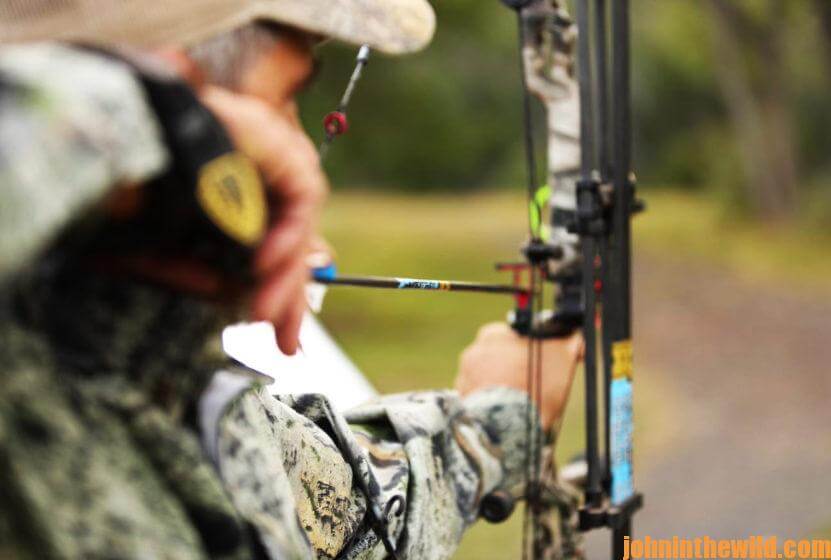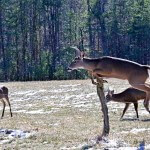Editor’s Note: According to Troy Ruiz, a cameraman and video producer for Primos Hunting (https://www.primos.com/) “We hunt three different states for elk. We hunt New Mexico almost every year, about every second year we hunt a ranch in Montana, and then we have a ranch we hunt in Colorado that’s very, very, very high at 13,200 feet of elevation.”
On this New Mexico hunt, this was my surprise bull elk because I didn’t even know this bull lived in the area I was hunting. I was the last person to hunt because I’d filmed other hunters who took four bulls in a week and a half. The day before my hunt I saw that the weather was about to turn bad with snow, sleet and rain. I only had z small window of time to try to find an elk and take him. All the bulls that had been taken on that hunt were taken in the late afternoons, when the elk were coming down off the mountain into the low country to feed at night. So, we all thought we’d get in front of the herd and let the elk come to us. On the day I was going to hunt, I had a perfect southwest wind blowing steadily all morning long. The place I wanted to hunt was some open country with meadows. It was right at the base of some hills. On this hunt Will Primos, Jordan Blisser, and Lake Pickle were with me.
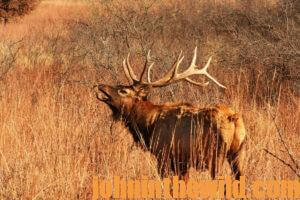
We came over a small rise, and Will started calling and got one bull’s attention. He came over the top of the ridge where we were set-up, but the bull was 50-yards away. So, I chose not to take the shot because the wind was blowing so hard, I knew it would affect my arrow. I decided there was too much room for error to take that shot, and I passed on that bull. When the bull left, Will came up to me and said, “I can’t believe you didn’t shoot that bull.” I was set-up 100 yards higher on the ridge than Will was, and when I told him what the wind was doing, and why I didn’t take the shot, he agreed with me. So, we stayed where we were and watched bulls chasing cows, trying to breed them down on the prairie below us.
We could hear one bull in the herd but couldn’t see him. He had a growly type of bugle, stayed in one place and wouldn’t come to us. We knew the property well enough to know that the bull was down in a drainage full of rocks and timber. As we continued to call to him and listen, he might move a foot toward us about every 10 minutes. I kept thinking, “That bull’s not going to get into bow range until after dark, if he keeps coming as slowly as he is.” I mentally wrote that bull off in my mind and eventually forgot about him. Then he became silent.
We started focusing all our attention on another bull in the herd that we knew was smaller than the big growling bull. That smaller bull answered our calls, but we could tell by his body language that he didn’t want to come to us. Later we learned that the big, growling bull elk was moving toward us to cut the little bull off and keep him from coming to what he believed to be a cow.
I never saw or heard this big bull until he bugled really close to us. That’s when I realized that the Growler, as we had named him, was on his way to us. When Will heard the bull bugle, he moved further away from me and laid down on the ground behind a little Christmas tree. The place we were hunting was flat as a pancake.
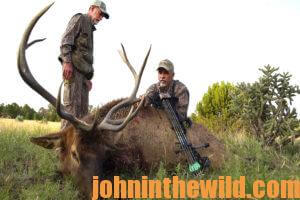 I thought, “All the odds are against my getting this bull to come to where I need him to be to take him with my bow.” However, the bull kept coming. I thought I’d better range some landmarks to know the distance to those landmarks if the bull did step out, and I had an opportunity to shoot. The best place for me to take the shot was 53-yards from my stand, but the wind was blowing hard.
I thought, “All the odds are against my getting this bull to come to where I need him to be to take him with my bow.” However, the bull kept coming. I thought I’d better range some landmarks to know the distance to those landmarks if the bull did step out, and I had an opportunity to shoot. The best place for me to take the shot was 53-yards from my stand, but the wind was blowing hard.
As I listened, the bull elk growled and bugled like he was really mad. So, I started praying, “Lord, I know I can make this shot, but You’ve got to calm this wind down, or I’ll not be able to make the shot.” The bull stepped behind a pine tree, I brought my bow to full draw, the wind stopped blowing, and the woods were silent. When he stepped out from behind the tree, he was walking. I attempted to stop him with a cow call. I didn’t want the elk to know where I was until I squeezed the trigger on my mechanical release.
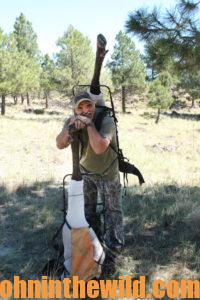 The bull didn’t stop, but was in no hurry to reach the opening. This bull’s rack wasn’t broken up at all. Since the wind had stopped, I knew I had to shoot. I aimed center mass on the bull’s lungs with my 50-yard pin, and my 60-yard pin on his heart. Then if the bull dropped down before he jumped or ran, I’d still hit him in the lungs. If he didn’t drop down, I’d hit him somewhere between the lungs and the heart. All those calculations and information were racing through my mind like lightning just before I released my arrow. I realized that this was the biggest bull I’d ever had the opportunity to take. Luckily when the bull stopped in the opening, he had his leg extended. My arrow hit him right in the heart. The arrow had flown straight, and the bull took off running and ran right past Will, who could see blood coming out of the left side of the bull. The bull ran out into the meadow and followed a cow, until he appeared to run out of gas and just fell over.
The bull didn’t stop, but was in no hurry to reach the opening. This bull’s rack wasn’t broken up at all. Since the wind had stopped, I knew I had to shoot. I aimed center mass on the bull’s lungs with my 50-yard pin, and my 60-yard pin on his heart. Then if the bull dropped down before he jumped or ran, I’d still hit him in the lungs. If he didn’t drop down, I’d hit him somewhere between the lungs and the heart. All those calculations and information were racing through my mind like lightning just before I released my arrow. I realized that this was the biggest bull I’d ever had the opportunity to take. Luckily when the bull stopped in the opening, he had his leg extended. My arrow hit him right in the heart. The arrow had flown straight, and the bull took off running and ran right past Will, who could see blood coming out of the left side of the bull. The bull ran out into the meadow and followed a cow, until he appeared to run out of gas and just fell over.
I was able to take our Polaris Ranger (https://ranger.polaris.com/en-us/) and drive right up to this bull that scored 353. I shot him with a Mathews VXR bow (https://www.mathewsinc.com/). I was wearing Mossy Oak (www.mossyoak.com) Bottomland pants, a Primos Bottomland turkey vest and I had on a Mossy Oak Obsession shirt with some green in it. I wanted the green in that pattern on the upper part of by body because I knew there were short trees where we were hunting, and I wanted to have that green on the upper part of my body.
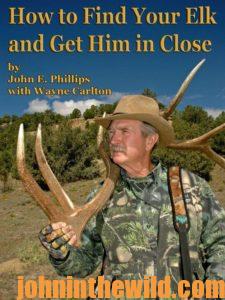 To learn more about elk hunting, check out John E. Phillips’ book, “How to Find Your Elk and Get Him in Close,” available in Kindle, print and Audible versions at http://amzn.to/17ENNqK. You may have to copy and paste this click into your browser. (When you click on this book, notice on the left where Amazon allows you to read 10% of the book for free).On the right side of the page and below the offer for a free Audible trial, you can click on Buy the Audible with one click.
To learn more about elk hunting, check out John E. Phillips’ book, “How to Find Your Elk and Get Him in Close,” available in Kindle, print and Audible versions at http://amzn.to/17ENNqK. You may have to copy and paste this click into your browser. (When you click on this book, notice on the left where Amazon allows you to read 10% of the book for free).On the right side of the page and below the offer for a free Audible trial, you can click on Buy the Audible with one click.
Tomorrow: How the McLemore Elk Was Taken



